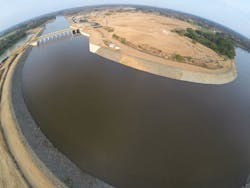Redefining Ecuador's Wastewater Treatment
To overcome polluted water sources and connect residents of Guayaquil to the network, the Las Esclusas wastewater plan will cost more than $100 million and generate its own power.
By Mauro Nogarin
Ecuador may be one of the richest countries in Latin America in terms of available water resources, yet the nation remains poor in terms of adequate water treatment infrastructure.
Although seven of every 10 people have access to drinking water, these sources can be contaminated with diseases and prove a great risk to health. Nearly three quarters of the watersheds below 2800m are not suitable for direct human consumption, due to contamination by pathogenic microorganisms.
One of the reason for this is that only 10% of wastewater collected has some level of treatment. Wastewaters with high organic loads from more than 80% of industrial companies are not cleaned and discharged directly into the sewage networks, or to rivers.
In light of these challenges, the Guayaquil City Hall decided to construct a major wastewater treatment plant in the city of Santiago de Guayaquil, located between the discharge of the Guayas river basin to the Pacific Ocean on the east, and to the Rio Estero Salado on the west side.
As the main hub of social and economic development, with three million inhabitants, Guayaquil is one considered one of the most important cities in Ecuador.
The sanitary sewerage system of the city of Guayaquil consists of 3,950 km of collectors and 61 pumping stations of wastewater, which provide coverage in excess of 90% of the service area. The city also has a separate sanitary sewer system and rainwater drainage; however, these sanitary sewage networks discharge into the Daule-Guayas Rivers.
During the dry season, a total of 280,000 m3/day of wastewater is generated, increasing to 350,000 m3/day during the rainy season.
The proposed project will benefit a population of 1.5 million inhabitants of the southern sector of the city of Guayaquil, and in particular, the inhabitants of the sectors called Isla Trinitaria, Guamo and Suburbio Oeste, where the sewage system will be rehabilitated and home connections will be installed. To finance this large work, a line of credit was requested from the World Bank and European Investment Bank for USD$102.5 million, with a contribution of USD$18 million, which is financed with funds from the Municipal Water and Sewage Company of Guayaquil EMAPAG EP, whose role is to control the execution of contracts in order to meet the schedule, cost and quality of the works.
The project is composed of three main components.
- Intra-home connections. The south of Guayaquil has 100% coverage of the Sanitary Sewage service and 82% of connectivity. This component aims to achieve 100% of connectivity by installing an approximate 30,000 new intra-household sanitary connections.
- Rehabilitation of the sanitary sewer La Chala. The La Chala basin, which represents approximately 65,000 families, currently has a poor sanitary sewer system with high levels of infiltration, will rehabilitate an approximate 40 km of collectors.
- The Treatment Plant Las Esclusas and their Complementary Components. Currently wastewater from the center and south of Guayaquil is transported to a preliminary treatment plant called La Pradera.
This component of the project will transform this plant into a pumping station that will drive the wastewater through a tunnel led drive line, one of the components of the Treatment Plant Las Esclusas.
Currently under construction, the Las Esclusas project has faced several challenges, according to José Luis Santos, general manager of utility Emapag-ep.
“The construction of the Las Esclusas WWTP represents three major challenges,” he says. “The soil where the project is based corresponds to a mixture of clay and sand, which in addition to generating settling problems generates liquefaction problems, for which a vibro-substitution method with tamping has been proposed.”
He says that construction is expected to take three years, with three months allocated for the start-up and six months of assisted operation.
Once complete, the Las Esclusas WWTP will effectively be a cogeneration facility and will use methane gases generated during the anaerobic digestion process as fuel to generate electricity for onsite power requirements. In total, the three cogeneration units have a capacity of 540 kWh each and an electric transmission line of 740 kWh.
Santos adds: “The universalization of a sanitary sewer for the southern part of Guayaquil will benefit more than one million inhabitants of the central and southern Guayaquil areas and will improve the quality of the waters of the Estero Salado and Guayas River, bodies of water that surround the city.”
Based in a Bolivia, Mauro Nogarin is a freelance contributor for WWi magazine.
More Water & WasteWater International Archives Issue Articles


